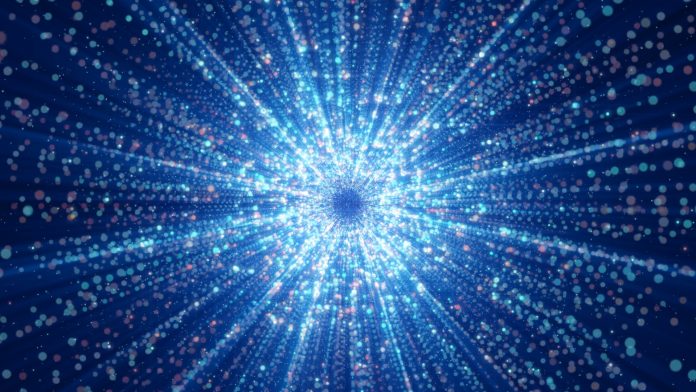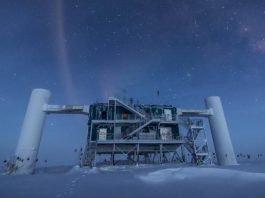New research led by NASA has identified a link between high-energy neutrinos and tidal disruption events.
Neutrinos are fundamental particles that outnumber all the atoms in the Universe. Astrophysicists are particularly interested in high-energy neutrinos, which have energies up to 1,000 times greater than those produced by the most powerful particle colliders on Earth. They think the most extreme events in the Universe, like violent galactic outbursts, accelerate particles to nearly the speed of light. Those particles then collide with light or other particles to generate high-energy neutrinos.
To study neutrinos, an international collaboration of scientists has built an ice telescope in Antarctica, the Cherenkov IceCube detector, with a volume of one cubic kilometre. In Russia, INR RAS, and JINR are now completing the construction of the Baikal GVD water telescope in Lake Baikal, the volume of which has already reached 0.4 cubic kilometres. Now data acquisition is underway on the running part of the facility, which had already been put into operation. These installations study the sky in different hemispheres: North and South.
Cosmic neutrinos provide scientists with unique insights into an otherwise hidden mechanism – particle acceleration in astrophysical objects. The IceCube Collaboration recently reported the likely association of one high-energy neutrino with a flare from the relativistic jet of an active galaxy pointed towards the Earth. However, a combined analysis of many similar active galaxies revealed no excess from the broader population, leaving the vast majority of the cosmic neutrino flux unexplained.
A recent paper, led by NASA, presents the likely association of a radio-emitting tidal disruption event, AT2019dsg, with a second high-energy neutrino. A tidal disruption event, or a tidal disruption flare, is an astronomical phenomenon that occurs when a star approaches sufficiently close to a supermassive black hole and is pulled apart by the black hole’s tidal force. A portion of the star’s mass can be captured into an accretion disk around the black hole, resulting in a brief flare of electromagnetic radiation as matter in the disk is consumed by the black hole.
Early research surrounding tidal disruption events suggests that they should be an inevitable consequence of massive black holes’ activity hidden in galaxy nuclei, whereas later theorists concluded that the resulting flare of radiation from the accretion of the stellar debris could be a unique signpost for the presence of a dormant black hole in the centre of a normal galaxy.
Tidal disruption events often occur when a star strays too close to a black hole. Gravitational forces create intense tides that break the star apart into a stream of gas. The trailing stream escapes the system, while the leading part swings back around, surrounding the black hole with a disk of debris.
In some cases, the black hole launches fast-moving particle jets. Scientists hypothesised that tidal disruptions would produce high-energy neutrinos within such particle jets. They also expected the events would produce neutrinos early in their evolution, at peak brightness, whatever the particles’ production process.
However, in a new article, published in The Astrophysical Journal, a team of Russian scientists argue that neutrinos of energies in the tens of TeV are also emitted by quasars. The team found that almost all high-energy astrophysical neutrinos are born in quasars. Some neutrinos are born in the Earth’s atmosphere, and even in the Ice Cube detector itself during the interaction of cosmic rays with matter.
Chief researcher of INR RAS and co-author of the discovery from LPI and MIPT, Yuri Kovalev, said: “It is amazing, since for the production of neutrinos with energies that differ by a factor of 100-1000 different physical conditions are required. The mechanisms of neutrino production in active galactic nuclei discussed earlier worked only at high energies. We have proposed a new mechanism for neutrino production in quasars, which explains the results obtained. While this is an approximate model, it is necessary to work on it, to carry out computer simulation.”
The link between high-energy neutrinos and tidal disruption events
Using ground- and space-based facilities, including NASA’s Neil Gehrels Swift Observatory, astronomers have linked high-energy neutrinos to an object outside our galaxy. The team traced the neutrino to a black hole tearing apart a star in a tidal disruption event.
Robert Stein, a doctoral student at the German Electron-Synchrotron (DESY) research centre in Zeuthen, Germany, and Humboldt University in Berlin, said: “Astrophysicists have long theorised that tidal disruptions could produce high-energy neutrinos, but this is the first time we’ve actually been able to connect them with observational evidence. But it seems like this particular event, called AT2019dsg, didn’t generate the neutrino when or how we expected. It’s helping us better understand how these phenomena work.”
AT2019dsg was discovered on 9 April 2019, by the Zwicky Transient Facility (ZTF), a robotic camera at Caltech’s Palomar Observatory in Southern California. The event occurred over 690 million light-years away in a galaxy called 2MASX J20570298+1412165, located in the constellation Delphinus.
Detecting high-energy neutrinos
Then, on 1 October 2019, the National Science Foundation’s IceCube Neutrino Observatory at the Amundsen-Scott South Pole Station in Antarctica detected a high-energy neutrino called IC191001A and followed its trajectory to a location in the sky. About seven hours later, researchers at ZTF noted that this same patch of sky included AT2019dsg. Stein and his team think there is a one in 500 chance that the tidal disruption is not the neutrino’s source.
Swift Principal Investigator S. Bradley Cenko at NASA’s Goddard Space Flight Center, said: “Tidal disruption events are incredibly rare phenomena, only occurring once every 10,000 to 100,000 years in a large galaxy like our own. Astronomers have only observed a few dozen at this point. Multiwavelength measurements of each event help us learn more about them as a class, so AT2019dsg was of great interest even without an initial neutrino detection.”
AT2019dsg’s UV emissions from its hot accretion disks plateaued shortly after they peaked, which is unusual because such plateaus typically appear only after a few years. The researchers suspect the galaxy’s black hole, with a mass estimated at 30 million times the Sun’s, could have forced the stellar debris to settle into a disk more quickly than it might have around a less massive black hole.
Why AT2019dsg’s X-ray emissions fade so quickly
Scientists think the X-rays come from either the inner part of the accretion disk, close to the black hole, or from high-speed particle jets. Stein’s team does not see clear evidence indicating the presence of jets and instead suggests rapid cooling in the disk most likely explains the precipitous drop in X-rays, which faded by 98% over 160 days.
An alternative explanation, authored by DESY’s Walter Winter and Cecilia Lunardini, a professor at Arizona State University, USA, proposes that the emission came from a jet that was quickly obscured by a cloud of debris. The researchers published their alternative interpretation in Nature Astronomy.
Many astronomers believe that radio emission in these phenomena come from the black hole accelerating particles, either in jets or more moderate outflows. Stein’s team have categorised AT2019dsg into the latter category. The scientists also discovered that the radio emission continued steadily for months and did not fade along with the visible and UV light, as previously assumed.
The neutrino detection, combined with the multiwavelength measurements, prompted Stein and his colleagues to rethink how tidal disruptions might produce high-energy neutrinos. The radio emission shows that particle acceleration happens even without clear, powerful jets and can operate well after peak UV and visible brightness. Stein and his colleagues suggest those accelerated particles could produce neutrinos in three distinct regions of the tidal disruption: in the outer disk through collisions with UV light, in the inner disk through collisions with X-rays, and in the moderate outflow of particles through collisions with other particles.
Stein’s team suggests AT2019dsg’s neutrino likely originated from the UV-bright outer part of the disk, because the particle’s energy was more than 10 times greater than can be achieved by particle colliders.
Co-author Sjoert van Velzen, an assistant professor at Leiden University in the Netherlands, said: “We predicted that neutrinos and tidal disruptions could be related, and seeing that for the first time in the data is just very exciting. This is another example of the power of multi-messenger astronomy, using a combination of light, particles, and space-time ripples to learn more about the cosmos. When I was a graduate student, it was often predicted this new era of astronomy was coming, but now to actually be part of it is very rewarding.”
NASA’s Goddard Space Flight Center manages the Swift mission in collaboration with Penn State, the Los Alamos National Laboratory in New Mexico, and Northrop Grumman Innovation Systems in Dulles, Virginia. Other partners include the University of Leicester and Mullard Space Science Laboratory in the United Kingdom, Brera Observatory, and the Italian Space Agency in Italy.









